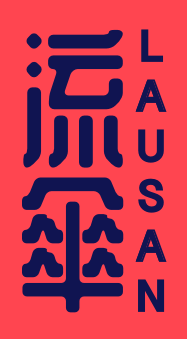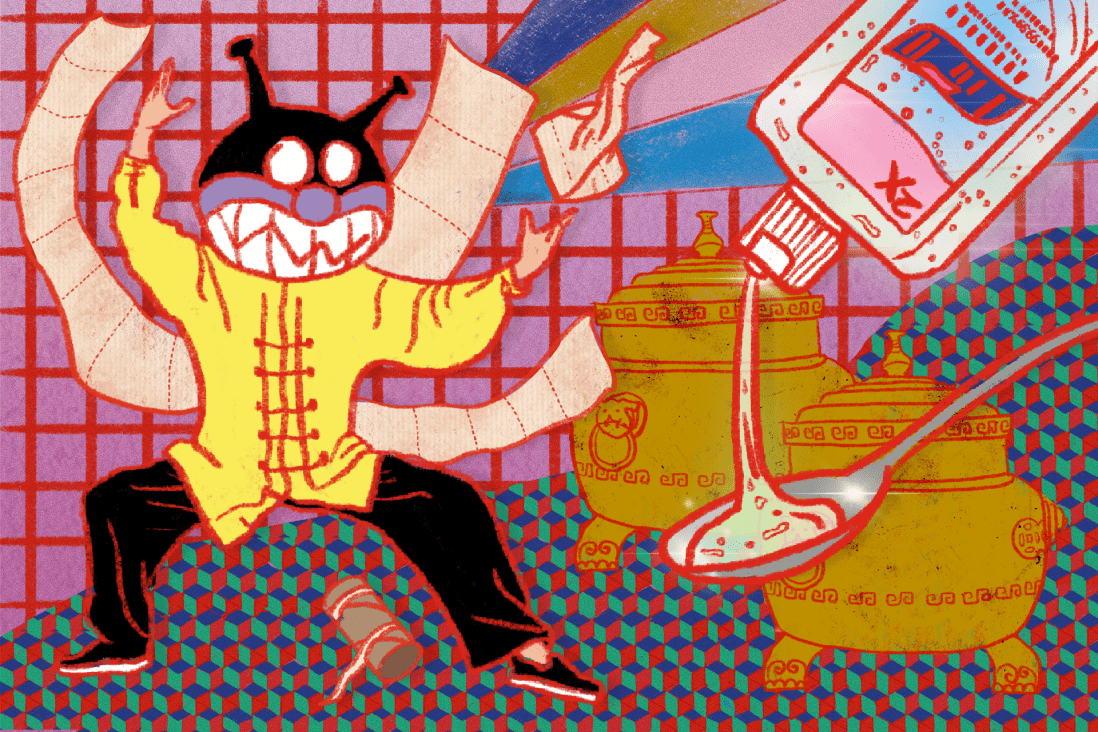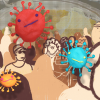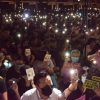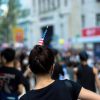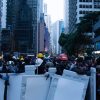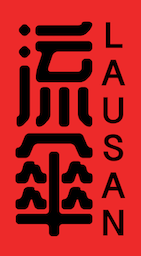Originally published in n+1. Republished with permission.
All graphics: spf.pdf for Lausan.
‘Wuhan virus’?
The city of Wuhan, China is rich with historical significance, but for much of the world before this year it was hardly a household name. A portmanteau of three historical cities at the mouth of the Yangzi and Han Rivers—Wuchang, Hankou, and Hanyang—Wuhan served as the site of the 1911 Xinhai Revolution, which ended the last Chinese Dynasty, and in 1937, Chiang Kai-shek’s Nationalist government temporarily made the city its national capital, as the military fled from Japanese forces along the eastern coast. In recent years, passengers boarding one of the hundreds of ferries that glide through the city center every day would have seen soaring glass and concrete skyscrapers adorned with the names of hotel chains and national banks—an intimidating skyline, but one increasingly common across Asia. Beyond this photogenic core is the familiar combination of new architectural projects, historical landmarks, residential university neighborhoods, and designated free-trade zones for industrial export processing. It is a massive and sprawling metropolis of over eleven million people, more populous than New York City, but by the high standards of contemporary China, and in the unsentimental parlance of the Chinese media, it is a solid “second-tier city.”
But these days, of course, Wuhan is at once more internationally infamous than ever and associated only with one thing: the global spread of the disease now known as Covid-19. During the first weeks of December, several individuals began to report to hospitals in the Wuhan area with severe flu-like symptoms, including fever, dry coughing, fatigue, body aches, and pneumonia-like symptoms. Only later did doctors recognize that many patients either worked at, or were connected to, the Huanan Wholesale Seafood Market in the city center. The symptoms soon worsened, paralyzing older patients and killing many. On December 30, lab results finally confirmed that the source was a novel coronavirus strain that shared traits with the 2003 SARS (severe acute respiratory syndrome) outbreak that claimed over eight hundred people worldwide and the MERS (Middle East respiratory syndrome) virus that emerged in 2012 and has killed nearly a thousand since. The virus has now ballooned into a pandemic with cases in 183 countries. As of this writing, 11,147 people have died from 265,495 cases. In China alone, 3,248 of 80,967 cases have died, almost all based in Wuhan.
For weeks, American news services referred to the disease as the “Wuhan virus.” Last month, the World Health Organization renamed the virus “Covid-19” (Coronavirus disease of 2019) with the explicit goal of minimizing the social stigma of a name that referred to a specific place—and, by extension, a specific people. Not ones to pay heed to international norms, conservative politicians in the US have continued to insist on the phrase “Wuhan virus,” or “Chinese coronavirus,” in a transparent effort to scapegoat and distract from their own catastrophic mismanagement of the worst public health crisis in recent American history. On Monday, a White House official reportedly described the virus as the “Kung Flu.” The following day Donald Trump defended using the term “Chinese virus,” explaining, “’cause it comes from China. It’s not racist at all, no, not at all. It comes from China, that’s why. I want to be accurate.” Less equivocal, Arkansas senator Tom Cotton paired a tweet last week about the “Wuhan coronavirus” with a suggestion that China would have to “pay” for what it had done to America.
There is no question that such terminology is racist and xenophobic. Yet the fact that this global pandemic started in Wuhan, and not elsewhere in China, should not be simply overlooked, either. In recent decades, Wuhan has been caught up in the latest stage of globalization, in which international capital continues to extend further inland in pursuit of cheaper land and labor markets, spawning international links for goods such as steel and automobile parts, which remain hidden to the average consumer. It is a major Chinese city, yet outside the core of glittering metropolises along the nation’s coast. It is precisely the unexceptional status of Wuhan as a second-tier Chinese city that is notable. What the global spread of the novel coronavirus from Wuhan suggests is that the culprit here is not the unique circumstances of a particular place, but rather the now-extensive commercial connections that bring ever more of these kinds of places closer and closer together, into a larger and larger whole. In recounting the story of the novel coronavirus, it becomes increasingly clear that its movements have thus far mimicked the pathways of the 21st-century global market.
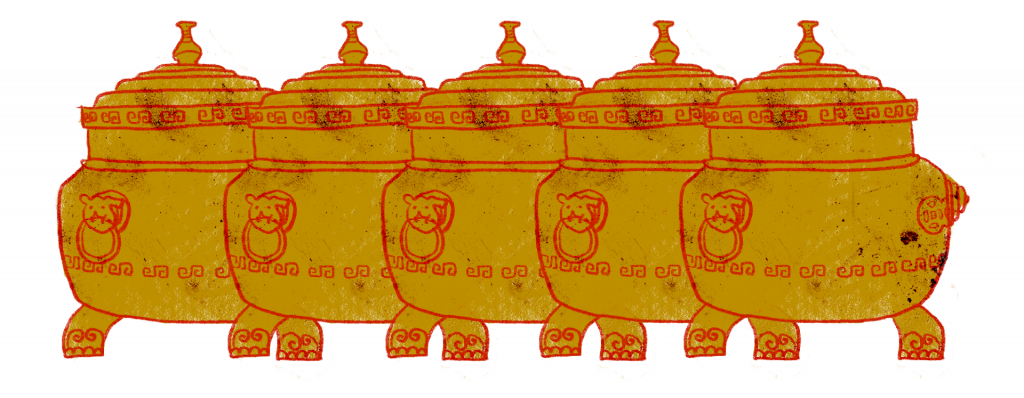
The specific origins of the coronavirus within Wuhan remain unclear. In February, researchers announced that the virus could be traced back to a wild pangolin sold in the Huanan market, and that it had originally been transmitted from a bat. This is currently just a working hypothesis. But if true, it would square with the theory that SARS and MERS also originated in bats and were passed on to humans by way of wild animals—civet cats and camels, respectively.
The pangolin is a small, anteater-like mammal found across Asia and Africa. Its hard scales, which make up 20 percent of its body weight, have been digested in China for centuries, with overall consumption soaring in recent decades. According to customers and vendors, pangolin scales and meat can be used as a form of medicine to cure a variety of ailments (it is said to nourish the kidneys), but primarily to invigorate men’s sexual performance and bolster female beauty. The exotic nature of the pangolin—and the illegal trading that is central to its distribution—has an obvious analogy in the masked palm civet cat, a small mammal native to India and Southeast Asia served as a delicacy in the southern Chinese province of Guangdong, usually prepared with chrysanthemum petals and shreds of snake.
During the 2003 SARS outbreak, investigators in Guangzhou, Guangdong’s massive provincial capital, raided restaurants and discovered bear parts, salamanders, and owls sitting in freezers in the kitchens. These dietary habits are typically described in the media as a branch of traditional Chinese medicine (TCM): practices, herbs, and medicinal cures that have been used for thousands of years in China. So is the novel coronavirus, like SARS, a tragic consequence of a national fondness for TCM? Was the consumption of pangolin a residue of unchanging, primitive Chinese custom? Could it be blamed on “local culture,” as the SARS virus was blamed on the exotic and peculiar tastes so dominant in Cantonese cuisine?[1] If so, would we have to concede that the novel coronavirus is indeed a peculiarly Chinese disease?
The pangolin trade owes more to the Chinese economic miracle than it does to some archaic superstitious culture.
Of course not. TCM, in fact, is not a particularly coherent or uncontroversial field. For most people, the term simply refers to acupuncture, or a harmless mixture of ginseng, ginger, goji berries, and jujube in teas and hot broths. While these remedies have existed in Asia for centuries, market prices and cross-border activity have transformed modest practices and local tastes into big business. Beginning in the 1980s, market liberalization opened opportunities for illicit trade and also made many in China rich. The rich were more than willing to seek new culinary adventures by way of that trade, as conspicuous consumption became the ultimate marker of class advancement. In interviews, customers have explained that they seek out rare wildlife delicacies not for their health benefits, but because they’re eager to impress important guests they’re entertaining—or because they’ve had a good day at the stock market. The pangolin trade owes more to the Chinese economic miracle than it does to some archaic superstitious culture.
Because the Chinese pangolin has been hunted to near extinction, most these days are trafficked from Southeast Asia, at the border with Myanmar or Vietnam; in recent years there have even been reports of Chinese markets acquiring varieties from Africa. Local sales of pangolins in Southeast Asia have faded, with suppliers turning their attention to the lucrative Chinese market, a clear illustration of how flexible and market-dependent the taste in wildlife is. By one estimate, some twenty tons of pangolins are shipped into China each year, either alive, frozen whole, or as dried and processed scales. Some of the headline-grabbing seizures include a 14-ton haul of frozen pangolins in Indonesia, 4.4 tons of scales seized in Hong Kong, and an 11.9-ton haul in Shenzhen, just across the border from Hong Kong. For this reason, most headlines from the pangolin trade are centered on the interstices of Southeast Asia and southern China, the crucial boundary zone of the black-market trade.
It would make perfect sense, therefore, if the coronavirus had broken out in the Pearl River Delta, encompassing Guangdong and Hong Kong, as SARS did. Looking back, the Delta of the early century was the most likely candidate in China for an outbreak on a global scale. At the time, Guangdong was the province most tightly linked with world supply chains and international finance, as Cantonese families had long migrated to Hong Kong and other overseas Chinese communities. With liberalization since 1979, they revived kinship ties in pursuit of business opportunities, as Hong Kong capital introduced the world market to handbag subcontractors in Dongguan. The initial SARS outbreak emerged from a Cantonese man who brought the disease to a massive hospital in Guangzhou. From there, a Guangzhou doctor carried it to a wedding in Hong Kong, and fellow hotel guests then brought it to Hanoi, Toronto, Singapore, Taipei, and Bangkok. In hindsight, the Guangdong/Hong Kong nexus appears as a perfect storm of wildlife consumption and global integration. (Tellingly, in the 2011 Hollywood film Contagion, a pandemic is traced to a Hong Kong chef who prepares a pig.)
But the novel coronavirus did not emerge from the Pearl River Delta, with all its unique geographical and cultural features. Instead it first appeared in Wuhan, five hundred miles inland from Shanghai and six hundred miles north of Hong Kong. Before 20th-century industrialization, Wuhan served as an intermediary hub between the ocean and inland China, facilitating the traffic in household goods such as rice, silk, furs, and leathers. (My own family briefly worked as petty tea merchants there in the early 1900s.) The most famous local dish is a breakfast of hot noodles in a dry peanut sauce sprinkled with scallions and sold in street stalls; if pangolin sales in Wuhan have risen in recent years, therefore, this likely reflects less the particularities of the Wuhan people than the increased fortunes of the Chinese economy as a whole.
And though Americans have long nicknamed Wuhan the Chicago of China, the comparison is inapt. Both became major industrial cities by the early 20th century, but Wuhan’s international links were far more modest. Even today, the fifteen thousand foreigners who resided in Wuhan before the outbreak amounted to less than one tenth the figures for ethnic-Chinese metropolises such as Beijing, Shanghai, Guangzhou, Hong Kong, Singapore, or Taipei.
Nevertheless, even Wuhan can evidently serve as the site for a global outbreak in the year 2020. Skimming the headlines of cases provides some clues as to how the novel coronavirus initially spread. The first wave of people who carried it overseas were the middle-class friends, co-workers, and relatives of residents of Wuhan. There was the Chinese woman working in Seoul who had recently visited Wuhan; the Wuhan woman who visited Bangkok; the tourists who traveled to Vietnam; the full-time Japanese resident from China who visited a Wuhan acquaintance; the German employees of a Munich-area supplier with branches in Wuhan; the Chinese technicians and Iranian businessman traveling between China and Qom, Iran; and the Shenzhen man who went home to see his relatives.
As evacuation stories mounted, so did accounts of global linkages. A Sudanese engineering student at the Wuhan University of Technology successfully avoided the virus and left after six weeks of self-quarantine. The governments of France, Germany, and Japan evacuated their own citizens from Wuhan. Some of these were employees in the automobile sector; companies such as General Motors, Renault, and Nissan have established branches in the export processing zone. And though the source of the Iran outbreak remains unclear, journalists speculate it resulted from the big business between the two economies (China is Iran’s top trading partner), typically Iranian crude oil in exchange for Chinese weapons and capital investment into local infrastructure.
What all these stories have in common is how unremarkable they are: this is contemporary global interchange at its most prosaic. Travel to and from countless other cities across Asia and Europe for business meetings and tourism follows a very similar pattern. Whereas the SARS outbreak was blamed on the peculiar, outlandish diets of the Cantonese people and then traveled through the elite cosmopolitan links between major Asian cities, the so-called “Wuhan virus” points to the utterly mundane way that countless nodal points around the world, including “second-tier” Chinese cities, are interwoven more tightly than ever across global circuits of commerce, education, and tourism.
Could the next Wuhan be Zhengzhou, Dayton, Bangalore, or Dar es-Salaam?
By comparison, during the “high socialist” era of the 1950s through the ’70s, the rapid spread of a Covid-19-like virus from a fishmonger in Wuhan to hundreds of countries in a matter of weeks would have been unimaginable. In 1957, an “Asian flu” diagnosed in January first traveled in predictable fashion from southern China to Hong Kong and Singapore; it didn’t fan out to the US and Europe until many months later, in the fall. Under a trade embargo by the US, the routes of commerce and travel between China and the world were far narrower, slower, and quieter. Notably, it was only during this window of relative isolation that the government officially stamped out the opium trade, before the infamous drug reentered the country with market liberalization.
But the world has changed. The many ties between Wuhan and the world today suggest a terrifying reality that should be clear to xenophobes and liberals alike. A viral outbreak in any one of these locations, it appears, could easily wind up touching the lives of hundreds of millions of others. Could the next Wuhan be Zhengzhou, Dayton, Bangalore, or Dar es-Salaam?
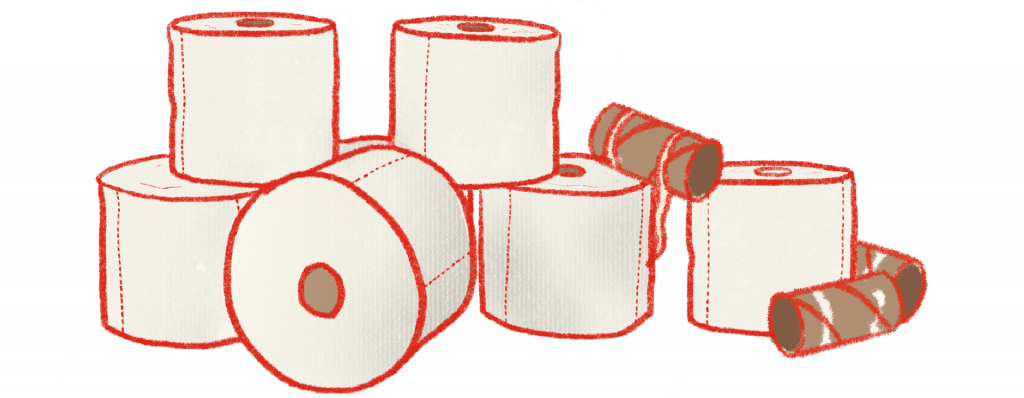
Market virus
The spread of the novel coronavirus has a clear scientific explanation rooted in the virus’s natural properties, about which researchers are furiously trying to learn more. What is known is that the virus’s crown-like shape comes from outer protein spikes that bind to the throat and then spread to living lung cells, which then produce more viruses that spread to new parts of the lungs and to other organs. But of course, the real-life distribution of the virus has also been shaped by historically specific political factors. It is not just a natural disaster but a social one as well. The coronavirus first traveled through animals sold on the Asian black market, first clung to human carriers in a seafood market, and first spread through the mundane routes of regional tourism, foreign business, and foreign education.
This coincidence between the spread of the coronavirus and the footprint of the marketplace explains why it has been so difficult to contain. As cases began to emerge in the Middle East, Oceania, Europe, and the United States, officials expressed skepticism that drastic measures were necessary to avoid an outbreak. If anything, their comments were focused on potential stock market losses rather than public health risks. It is not that they did not realize the potential health impacts, but that they understood how sickness would prevent people from spending money and going to work. This attitude was crystallized by the outlandish statements of CNBC editor Rick Santelli who said on March 5, “Maybe we’d just be better off if we gave it to everybody, and then in a month it would be over . . . But the difference is [right now] we’re wreaking havoc on global and domestic economies.” Santelli was rightly pilloried by commentators across party lines, but his comments were also an honest expression of the ways governments and businesses are now being forced to weigh corporate profits against human life to a newly extreme degree.
In the United States, cases had begun to break out in Washington state and California for weeks before Americans started to take the virus seriously. One turning point was last Wednesday, when basketball player Rudy Gobert became the first professional athlete to test positive for the coronavirus, only days after he had mocked the possibility of an outbreak by wiping his hands over microphones and equipment in the locker room. Within minutes, actor Tom Hanks wrote on social media that he and his wife had also tested positive while traveling in Australia. These revelations seem to have accelerated the American response: within days, all major sports leagues were canceled, schools were closed, and a national state of emergency was declared. The most obvious—albeit imperfect—analogy is the blasé attitude so many Americans had taken towards the HIV/AIDS epidemic in the early 1980s, reversed only when actor Rock Hudson and then NBA star Magic Johnson revealed their own positive diagnoses. In the United States, diseases do not appear real when they spread among ordinary people out of the spotlight. It is only when they affect wealthy celebrities and athletes that they begin to be taken seriously.
We are now left with the absurd reality of the richest country in the world wholly ill-prepared for collective responsibility and action.
As a result, we are now left with the absurd reality of the richest country in the world wholly ill-prepared for collective responsibility and action. In a society that has systematically dismantled its welfare state for nearly a half-century, where the supposedly “left-wing” political party regularly throws temper tantrums over the cost of health care, and which has literally installed a real estate developer as its President, we face the remarkable situation that pandemic measures are now being shouldered almost entirely by local and private actors, that reliable testing has been secured by the Gates Foundation and the Utah Jazz but not made publicly available by the Centers for Disease Control and Prevention.
The novel coronavirus initially emerged and spread across the world through market activities, and our ability to tame it now will be decided by the degree to which we can subordinate market logics to our own survival, rather than vice versa. The endless reports of Americans unable to pay for coronavirus tests, unable to work from home, unable to limit their own exposure to public places and gatherings—health care workers, especially—are an index of the general population’s varying levels of market dependence, or, what amounts to the same thing, class. Disparities that have been growing more acute and life-threatening for decades have suddenly become apocalyptic.
Just last year, a Federal Reserve study reported that nearly 40 percent of Americans would struggle to cover an emergency expense of $400, either due to lack of savings or because their earnings were already earmarked for credit card, medical, and student loan bills. Meanwhile, reports suggest that the cost of a coronavirus test initially ranged $1,400 to $4,000. The coronavirus endangers the twenty-seven million people without health insurance and, in particular, the twenty-three million who live paycheck to paycheck, including those who work hourly-wage salaries in the hotel and food industries, many of whom do not get sick pay and who fall outside the relief package currently in Congress, which, under pressure from McDonald’s and Walmart, exempts large and small employers and only covers ten days of work. All of these people are captive to subsistence wages that make an exit from work—and any disruption—potentially ruinous.
The best safeguard against the novel coronavirus is the ability to voluntarily withdraw oneself from capitalism. Therein lies the problem.
On the other end of the spectrum are the hoarders. The spread of the virus and its attendant horror stories has been accompanied by articles about the super-rich chartering private jets to fly overseas and to disaster bunkers in Indiana and South Dakota. Gwyneth Paltrow documented her escape to Paris via Instagram, jokingly referencing her role in Contagion (her character was the one who spread the virus from Hong Kong to the US). Elsewhere, billionaires have inquired with private hospitals about early vaccine treatments and exclusive testing kits—and as more athletes and entertainers reveal their test results on social media, the secret medical hotline for wealthy celebrities indeed appears intact and functioning.
But there are also more common forms of indefensible excess: the many stories playing out in the news, on social media, and in group chats of suburban parents fiercely raiding grocery stores for home supplies, emptying shelves and stockpiling weeks of food in basement freezers. In Australia, hoarding has gotten so bad that one coffee shop began to accept payments in toilet paper. In this respect, the super-rich and the middle classes have much in common. Both groups are financially secure enough and have enough accumulated wealth to possess the luxury of withdrawing from the marketplace and, by extension, its face-to-face interactions.
Thus, whereas economic need has forced service workers to remain constantly exposed to the virus, for the well-off, it is their wealth that protects them. What American pundits misunderstand when they brandish “market choice” as a weapon against social welfare, then, is that the social safety net does not extinguish human freedom but instead acts as its very condition of possibility (philosophers have called this the distinction between the realm of necessity and the realm of freedom). Indeed, the best safeguard against the novel coronavirus is the ability to voluntarily withdraw oneself from capitalism. Therein lies the problem.
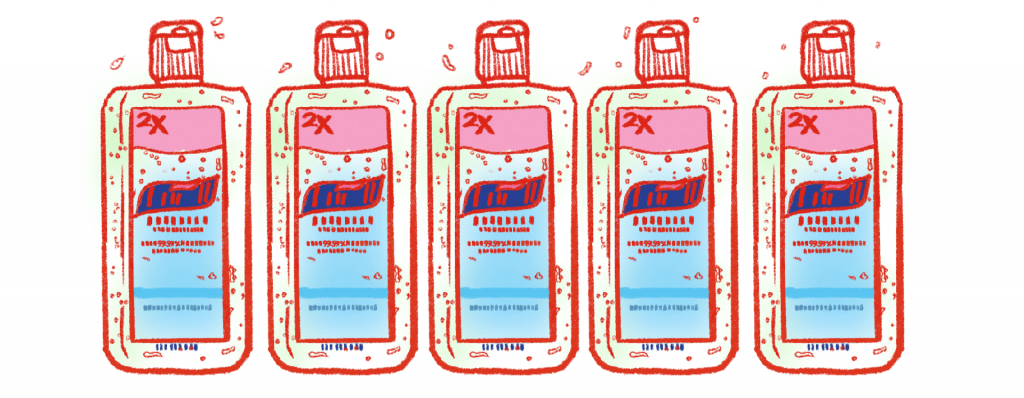
Value virus
The irony of the term “Wuhan” or “Chinese virus” is that the most successful and responsible government responses have been in the ethnic-Chinese-majority territories of Hong Kong (four deaths in 256 cases), Singapore (no deaths in 385 cases), and Taiwan (one in 135). Scarred by the SARS outbreak, these governments responded aggressively in January by screening arrivals from Wuhan, implementing travel restrictions (against the WHO’s recommendations), and promoting society-wide policies on school and workplace activity, stringent assessments of hospitals, and regular public announcements. The number of cases in these countries has fallen behind those of Iceland, and the newest ones have arrived from passengers traveling not from mainland China, but from Europe and the United States.
Though there is no vaccine yet for the novel coronavirus, these governments have provided the most straightforward institutional solution: large-scale testing and self-quarantining. Until a cure can be found, our best hope in the US, according to public health experts, is to “flatten the curve” and distribute cases evenly enough that our private health care system does not become overwhelmed—or as overwhelmed as in the worst-case scenarios. Nevertheless, government agencies and businesses here are refusing to implement these solutions effectively, because—as Rick Santelli made clear—they stand in direct conflict with the commercial demand to constantly produce, sell, and purchase goods.
The coronavirus has throttled international stock markets and distressed its transnational supply chains, cutting off China’s ability to produce for the rest the world. Because mainland Chinese citizens are the world’s top tourists, overseas restrictions and domestic quarantining have meant that travel has plummeted, a gut punch to Southeast Asia, Japan, and Hawai’i. In manufacturing, China has famously become the latest workshop to the world, providing everything from dried mushrooms to blue jeans to smart phones. Because Wuhan is a center for automobile parts manufacturing, weeks after the coronavirus shut down the city, overseas car plants such as the Fiat-Chrysler outpost in Serbia and Hyundai factories in Korea halted production because their Chinese suppliers had stopped producing. Apple has already announced projected losses for the year, not only because its Chinese factories have closed, but also because so much of its sales rely on Chinese consumers. About 30 percent of global container shipping is processed through Chinese ports, the busiest in the world, but thus far in 2020, over one quarter of shipments to North America have been canceled.
The slowdown of travel and construction has also tanked the world’s largest commodity markets. China is the world’s top importer of crude oil, shipping in the equivalent of ten million barrels daily, but as Chinese activity and then global travel slowed, oil stocks have piled higher and higher. For the first time since 2009, energy analysts project overall consumption will fall this year. In this shrinking, zero-sum game, Saudi Arabia this past week decided to accelerate the stakes of competition by announcing an upsurge of crude oil production and lower prices, shredding a 2017 agreement with Russia to limit production. Because it enjoys the cheapest production costs of all countries, Saudi Arabia gambled that it could simply elbow out competitors through rock-bottom prices. Though aimed at Russia, this gambit has caused collateral damage to medium-sized producers like Venezuela and Iran, not to mention American shale companies; when the Dow Jones opened last Monday, it fell 5 percent.
Metals markets have been similarly hurt. China is the top exporter of steel, aluminum, and key mineral inputs such as manganese alloys and silicon; when the coronavirus outbreak began, the major threat was thus severed supply chains. Instead, Chinese activity has now mostly recovered, but the metal industries are facing the bleak prospect of glutted supplies while the rest of the world’s producers and consumers become paralyzed by the pandemic. Because steel and aluminum plants are too expensive and risky to stop, companies never halted production. The current surplus will already take months to resolve. Chinese inventories for aluminum have doubled since December, and steel inventories are 45 percent higher than a year ago.
Containing the spread of the coronavirus, then, is about more than practicing good hygiene. On trial is a whole global system of profiteering and its structural laws and incentives.
Such dynamics expose a basic absurdity at the heart of our global society. It is not a system aimed at satisfying our desires and needs, at providing humans with greater amounts of physical utility. It is instead governed by impersonal pressures to turn goods into value, to constantly make, sell, buy, and consume commodities in an endless spiral. Unlike an earthquake or famine, the coronavirus outbreak has not destroyed our capacity to make things; indeed, it has resulted in perhaps the greatest ever accumulation of two of the most useful substances known to humanity, oil and steel. But several weeks of quarantining have decimated their value, tanking currencies, stock market indexes, and personal savings. Instead of enriching us and relieving us of natural wants, this glut of goods is only making us poorer. Given this irrational social system of organizing wealth and value, it is no wonder that so many societies have found it impossible to contain the coronavirus by asking citizens to limit commercial activity.
Containing the spread of the coronavirus, then, is about more than practicing good hygiene. On trial is a whole global system of profiteering and its structural laws and incentives. What the pandemic has revealed is not just that companies are out to get rich—a story as old as time—but specifically our unprecedented degree of global interdependence in the year 2020. The Saudi oil rigs and the Chinese steel factories are working just fine, but with the US and Europe under quarantine, these industries, and the global economy, may just implode. The international division of labor cannot survive today unless all of its parts remain healthy.
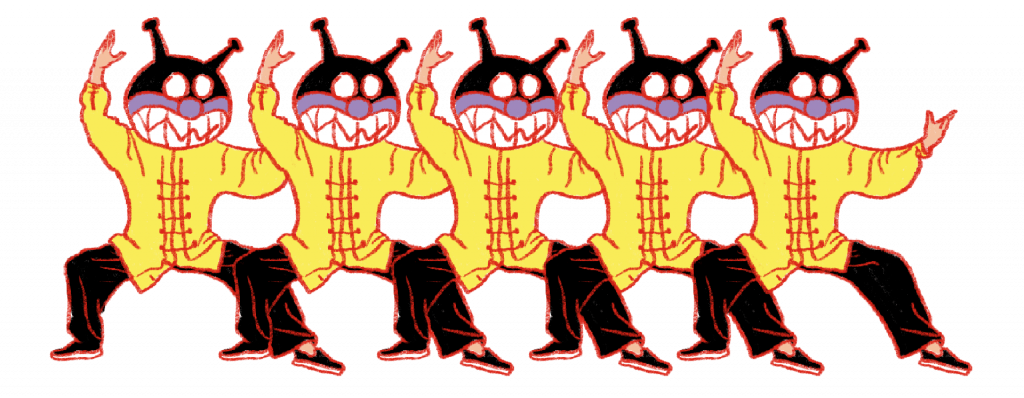
Nationalism virus?
After concealing the crisis for much of January and punishing whistleblowers, the Chinese state finally acted to combat the virus in Wuhan while projecting to the outside world an image of exemplary governance. Foreign media accepted this characterization uncritically, as one WHO official declared, “China actually is setting a new standard for outbreak response, and it’s not an exaggeration.” But Chinese citizens were far more skeptical. On February 7, 2020, a 34-year-old doctor named Li Wenliang, who had been initially punished for trying to tell friends about the new coronavirus, died suddenly. His story inspired an outpouring of anger and melancholy on Chinese social media. In early March, Vice Premier Sun Chunlan visited Wuhan for a PR opportunity but was bombarded with public chants that “It’s all fake!” in clips posted online. Social media users pointed out in early February that the daily reported case-fatality rate appeared stuck at 2.1 percent and that if you charted the numbers of cases over time on an X-Y axis, you would get a perfect circle.[2]
Meanwhile, American ideologues have tried to convince themselves that the Chinese response was fatally flawed. In authoritarian China, they say, data has been unreliable, communication opaque, and the leaders rule through fear. All valid criticisms. But has the US government response been that much better? After hearing President Trump talk openly about keeping an infected cruise ship at sea in order to depress case numbers, reading about senators who traded stocks based on confidential meetings while publicly denying the virus’s threat, and watching middling bureaucrats comply with White House orders out of cowardice and self-preservation, it is becoming increasingly difficult to draw a bright line between the dysfunctional autocracy and the orderly democracy.
This week, both sides have devolved into a petty contest of conspiracies. The Chinese state has now banned all US journalists, and Foreign Ministry spokesman Zhao Lijian has blamed US soldiers for planting the virus in Wuhan in October, moves intended to control the PRC’s international image. In retaliation, Trump went out of his way this week to repeat the phrase “Chinese virus.” But for its part, the PRC government has at least reversed its initial disastrous mismanagement and subordinated its market economy to a robust state-owned sector, hastily producing face masks, medicines, and impromptu 1,600-bed hospitals without consideration to financial losses. At this point, such measures would be a huge relief in the US.
It is becoming increasingly difficult to draw a bright line between the dysfunctional autocracy and the orderly democracy.
This is not to equivocate between two radically different and profoundly imperfect societies but to suggest that the spread of the virus is now completely undermining the typical way Americans have long consumed news about China, within a simplistic framework of east versus west. It is unsurprising that racist conservative politicians and media figures obsessively talk of the “Wuhan virus.” But there are many liberal-minded figures who have expressed a subtler kind of American exceptionalism, too.
The same night Rudy Gobert’s positive coronavirus test was announced, ESPN cameras caught Dallas Mavericks owner and Shark Tank star Mark Cuban reacting in real time, snapping his upper torso backwards and yelling to others, “Did you see this!?” Later asked what he was thinking, he said: “This is crazy. This can’t be true. I mean, it’s not within the realm of possibility. It just seems more like out of a movie than reality.” The same day Cuban made these comments, China had already logged over 80,000 total cases and in Italy alone 196 people had already died. What other signs was he looking for? Cuban’s incredulity embodies a broader attitude that became increasingly apparent among Americans last week: that in spite of clear, mounting scientific evidence of an inevitable pandemic, they were not only naive but even in arrogant denial about its possibility in their own country. There are few clearer displays of American exceptionalism than the way institutions and corporations—sports leagues, local governments, concert venues—paid lip service to consulting experts and authorities while betraying in their actions that they did not think a pandemic was inevitable or even probable.
Common to all these responses was an underlying American belief that the coronavirus was a distinctively Chinese problem. Virus epidemics? City closures? Those were things that happened “out there,” in the poor and non-white countries but certainly never over here. Now, such myopic east-west thinking has proven self-sabotaging, as the US government has revealed itself as extraordinarily unprepared for the outbreak and as so many American citizens have proven to be socially irresponsible to a staggering degree, attempting to price gouge for hand sanitizer and packing restaurants and bars long after the numbers have begun ascending the same steep path as Italy and Iran before them. Viruses transcend borders. They make a mockery out of powerful politicians and nationalist hubris.
It is worth underlining again how the story of the spread of the coronavirus to this point cannot be disentangled from the role of the market in our world today. It is those most intimately dependent upon the market for their daily survival who are most at risk of infection. And if you map the nodal points of travel and trade with China (Seattle, Seoul, Qom), you will discover the locales first hit by the outbreak and through which the pandemic continued to spread. For those on the frontlines and in the most precarious economic positions, the virus and the market are inseparable, almost synonymous. What the latter hasn’t yet destroyed through decades of austerity, the economic impact of the former now threatens to.
By now, the numbers of new deaths and cases inside Asia are far outweighed by those outside. Can we still plausibly call this the “Wuhan virus”? It is clear that no matter its origins, it is now a global virus, and the threat of its spread will test the collective capacity of the entire world to act responsibly and distinguish between long-term goals and short-term interests. Above all, the next few weeks will act as a referendum on the irrational system of politics and profiteering that we have installed in the 21st century—a system that thus far is failing us now, at precisely the worst moment.
Footnotes
[1] https://www.chron.com/opinion/outlook/article/Food-for-thought-SARS-link-to-Cantonese-cuisine-2111623.php
[2] https://twitter.com/DustyFukuyama/status/1225302415324274688
